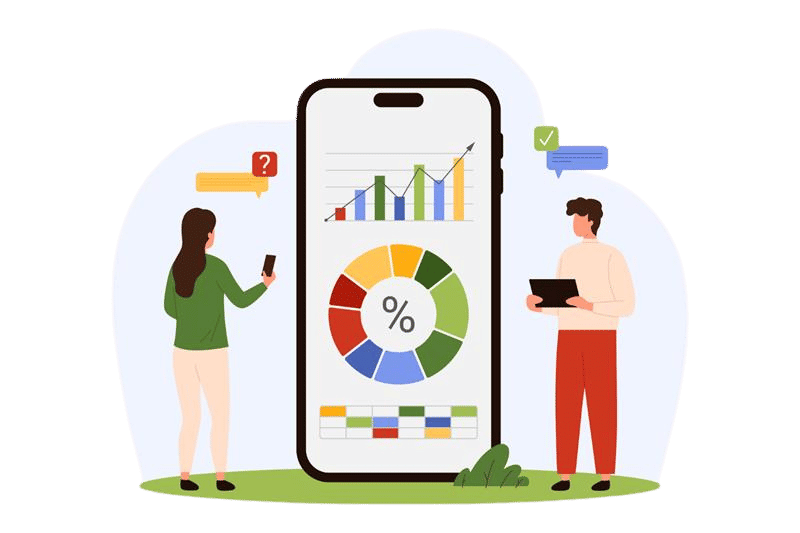
Performance Review Apps for Smarter HR Decisions
A performance review app gives HR leaders the power to make faster and smarter decisions. Traditional reviews are often biased, slow, and ineffective. Research shows that only 2 in 10 employees strongly believe reviews help them improve performance.
✨
Quick Read
Summary generated by AI, reviewed for accuracy.
A performance review app helps HR leaders move beyond slow, biased, and outdated reviews. With real-time feedback, automation, and analytics, these tools save time, ensure fairness, and create meaningful conversations that drive engagement and growth.
Modern employee performance review tools offer continuous check-ins, 360-degree feedback, goal alignment, and AI-powered insights. Companies using them see higher engagement, lower turnover, and better workforce planning. For HR, the message is clear embrace smarter review technology to stay competitive and build a culture of trust.
By using digital review apps, HR can link feedback with real results. Deloitte reports that companies with regular tech-enabled reviews see 30% higher engagement.
For Review Apps for Smarter HR Decisions”> HR teams, this shift is more than just convenience it is about building trust, improving fairness, and creating a culture where employees feel recognized. With the right performance review tool, organizations can turn evaluations into growth opportunities, not stressful events.
What Is an Employee Performance Review App?
An employee performance review app is software that helps HR and managers measure employee progress in a clear and simple way. It gives real-time feedback, creates automated reports, and organizes data so reviews become faster and more accurate. Instead of struggling with spreadsheets or long forms, HR teams can manage everything in one place. This makes the review process easier, reduces errors, and helps employees feel guided and supported rather than judged.
For HR leaders, the biggest value lies in turning reviews into meaningful conversations. A good performance review app builds trust between managers and employees, ensures evaluations are fair, and provides insights that guide promotions, training, and growth. It helps organizations focus on people, not paperwork, and creates a culture where every employee feels motivated to do better.
Beyond performance tracking, these apps also help HR spot trends across teams and departments. By using real data instead of guesswork, leaders can see which employees need support, which teams are excelling, and where to invest in development. This not only makes decisions more accurate but also strengthens long-term workforce planning.
Why HR Needs Smarter Performance Review Tools
HR today is no longer limited to handling compliance. Its role has expanded to shaping growth, building culture, and keeping employees engaged. Yet, when performance reviews rely on outdated methods, they often fail to achieve these goals.
This is where a smart performance review software makes a real difference. It brings all performance data into one place, making decisions faster and more accurate. Reviews become fairer, promotions more transparent, and feedback more continuous. Instead of being seen as a one-time task, performance conversations become an ongoing process that supports both employees and managers.
Research highlights the impact of this shift. Deloitte found that companies using regular, technology-driven performance reviews experience 30% higher employee engagement, proving that better tools lead to stronger results.
Manual Review vs. Traditional Performance Review
While both approaches aim to evaluate employees, the experience and results are very different.
Manual Reviews
- Time-Consuming
Preparing review forms, printing documents, and following up with managers can take weeks. HR often spends more time managing the process than focusing on people. - Prone to Errors
Spreadsheets and paper forms are easy to misplace or miscalculate. A single formula error can affect the fairness of an employee’s evaluation. - Inconsistent Standards
Different managers often use different approaches to scoring, which leads to bias. One employee might be rated too strictly, while another gets lenient feedback. - One-Time Event
Reviews are usually done once a year. Employees wait months for feedback, which makes it hard to adjust their performance in real time. - Low Engagement
Employees often feel reviews are about pointing out mistakes instead of helping them grow. This reduces trust in HR and managers. - Paperwork Overload
HR has to deal with forms, signatures, and filing. This not only wastes time but also increases the chance of losing important records. - Delayed Decisions
Promotions, bonuses, and training plans take longer because managers don’t have updated performance data. This delay frustrates employees who expect timely recognition. - Limited Insights
With data scattered in different places, HR cannot easily track trends. This makes it difficult to identify skill gaps, future leaders, or high-performing teams. - Stressful for All
Managers dread the process, employees feel anxious, and HR struggles to coordinate. Instead of being constructive, reviews become a burden.
Performance Review App
- Automated Workflows
The app handles scheduling and reminders automatically, ensuring every review happens on time. HR no longer wastes hours chasing managers to complete evaluations. - Accurate and Organized
All performance data is stored in one system, reducing the risk of errors. Reports can be generated instantly, providing a clear and consistent view of progress. - Fair and Standardized
Every employee is measured using the same framework. This reduces favoritism and helps create a culture of fairness across the company. - Continuous Feedback
Employees and managers don’t have to wait for yearly reviews. Feedback can be shared weekly or monthly, making it more relevant and actionable. - Higher Engagement
Regular recognition and constructive feedback keep employees motivated. When workers feel valued, they are more likely to stay loyal to the company. - Less Paperwork
Digital platforms eliminate the need for manual forms. Everything is done online, which saves HR time and reduces clutter. - Faster Decisions
With up-to-date performance data, leaders can make quick choices about promotions, pay raises, or training needs. This ensures employees are rewarded fairly and on time. - Deep Analytics
Advanced dashboards show patterns in performance, highlight top performers, and point out areas for improvement. HR gains insights that drive smarter workforce planning. - Mobile Access
Apps allow managers and employees to complete reviews from anywhere. This is especially useful for remote teams, ensuring feedback remains consistent across locations. - Employee Growth Focus
Instead of just judging performance, modern apps create development plans. Employees get clear career paths, coaching support, and learning opportunities to help them grow.
Research shows that companies using digital review apps see 30% higher engagement and up to 24% lower turnover. Employees also report feeling 69% more valued when reviews are continuous and supported by technology.
Key Features HR Should Look in Employee Performance Review Tool
When choosing a performance evaluation app, HR leaders should look for features that solve their biggest challenges and support both managers and employees. The right tool goes beyond basic reviews and creates a full system for feedback, growth, and decision-making. Key features include:
- Automated Review Cycles
A smart app makes sure review cycles run smoothly by sending automatic reminders and tracking progress for every employee. This prevents missed deadlines and saves HR from chasing managers to complete evaluations. - 360-Degree Feedback
Modern performance review apps allow feedback from managers, peers, and even self-assessments. This balanced view reduces bias and helps employees see how their work impacts the entire team, not just their direct manager. - Integration with HR Systems
Seamless integration with HRIS and communication platforms keeps all employee data connected. This means performance results can easily tie into promotions, salary changes, and training plans without extra manual work. - Customizable Templates
Every company has its own culture and values. Customizable templates let HR design review questions and scoring systems that reflect organizational priorities instead of using rigid, generic formats. - Analytics Dashboard
Real-time dashboards give HR leaders insight into trends across departments. They can spot top talent, identify employees who need support, and make decisions based on reliable data rather than gut feeling. - Mobile Access
With remote and hybrid work becoming normal, mobile access is essential. Managers and employees can share feedback instantly, no matter where they are, ensuring reviews stay continuous and connected. - Goal setting and Alignment
A strong performance review app links individual goals to company objectives. This keeps employees focused on the bigger picture and helps HR track progress toward organizational success. - Continuous Feedback
Instead of waiting for yearly reviews, employees and managers can exchange feedback regularly. This reduces anxiety, improves communication, and makes performance discussions more natural and productive. - Employee Recognition Tools
Built-in recognition features let managers celebrate achievements quickly. Small, timely appreciation boosts morale and encourages employees to stay motivated and engaged. - AI-Powered Insights
Some advanced apps now use data-driven insights to detect patterns, predict which employees might be at risk of leaving, and recommend training or support programs. This helps HR stay proactive rather than reactive.
By focusing on these features, HR teams can choose a performance review app that not only saves time but also improves decision-making, strengthens culture, and supports long-term growth.
The Challenge HR Faces with Performance Reviews
For years, annual reviews were seen as the main way to measure employee performance. But in today’s fast-moving workplace, this old system shows clear weaknesses. Traditional reviews often create more frustration than value, leaving both managers and employees dissatisfied.
Here are some of the biggest challenges HR teams face with outdated review methods:
- Too Time-Heavy
Managers spend weeks preparing reports, filling out forms, and chasing deadlines. Instead of focusing on coaching employees, most of their energy goes into paperwork. - Risk of Bias
Without structured data, reviews can be influenced by personal opinions, favoritism, or recency bias where only recent actions are remembered. This creates unfair outcomes - Stressful Experience for Employees
Many employees see reviews as one-way conversations where they are judged, not guided. This leads to anxiety, low trust, and disengagement. - Weak Connection to Business Goals
Reviews often happen in isolation and are not linked to company objectives. HR finds it hard to show how employee performance supports overall growth. - Delayed Feedback
Annual or semi-annual reviews mean employees wait months to hear about their progress. By the time feedback arrives, it is often too late to make improvements. - Limited Data Insights
Manual reviews rarely provide meaningful analytics. HR leaders cannot track trends across teams or identify skill gaps that affect the company’s future.
According to Gallup, only 14% of employees strongly agree that traditional performance reviews inspire them to improve. This highlights the urgent need for a smarter, more supportive approach.
Benefits of Using Performance Review Apps
When HR introduces an employee performance review app, the advantages go far beyond just speeding up evaluations. These tools reshape how organizations manage people, decisions, and culture. The positive impact can be felt across every level of the company.
1. Save Time and Reduce Admin Work
One of the biggest advantages of review apps is the time they save for HR and managers. Automated reminders make sure reviews happen on schedule, while pre-built templates simplify the process for managers. Instead of wasting hours building forms or chasing deadlines, everything can be tracked from a single dashboard. This efficiency means HR can spend more time on strategy and employee growth rather than being buried in admin work.
2. Create Fair and Consistent Reviews
Fairness is a common challenge in performance evaluations. A review app reduces bias by using structured scoring systems and real-time performance data. Every employee is measured on the same criteria, which improves consistency and builds trust. The transparency of digital reviews also ensures that employees understand how their performance is being evaluated, removing doubts about favoritism or unfair treatment.
3. Boost Employee Engagement
Engagement rises when employees feel seen and supported. With a performance review app, feedback is shared more often, not just once a year. Regular recognition motivates employees, while open two-way conversations replace stressful, one-sided evaluations. This helps build a culture of continuous improvement where employees know their contributions are valued.
4. Provide Data-Driven HR Insights
For HR leaders, having reliable data is critical. A review app gives deep insights into performance trends across teams and departments. Leaders can identify high performers for succession planning, spot areas where employees need training, and align workforce performance with company goals. In fact, 89% of HR leaders say data-driven insights from review apps help them make smarter talent decisions.
5. Support Employee Growth and Development
A performance review app is not just about measuring past work it also supports future growth. Many platforms include goal-setting features and personalized development plans. This gives employees clear paths for improvement and career progression. When people see opportunities to grow within the company, they are more motivated and less likely to leave.
6. Improve Retention and Reduce Turnover
Turnover is costly for every organization. By offering fair reviews, frequent feedback, and recognition, review apps help employees feel more valued. Research shows that companies using digital performance tools experience 24% lower turnover rates. Retaining talent not only saves money but also strengthens company culture.
7. Strengthen Manager-Employee Relationships
Performance review apps encourage regular communication between managers and employees. Instead of waiting for formal meetings, managers can provide quick feedback and recognition throughout the year. This strengthens relationships, improves trust, and creates a healthier work environment where employees feel supported.
8. Ensure Scalability for Growing Companies
As organizations expand, managing reviews manually becomes almost impossible. A review app grows with the company, handling more employees, departments, and locations without adding extra stress to HR. This scalability ensures consistency in performance management, no matter how large the workforce becomes.
By combining time savings, fairness, engagement, insights, and growth opportunities, a performance review app becomes more than just a tool it becomes a foundation for smarter HR decisions and long-term success.
How Performance Review Apps Improve HR Decisions
HR leaders make choices every day about promotions, pay, training, and retention. Without solid data, these decisions can feel like guesswork. An employee performance review app removes the uncertainty by providing structured insights that guide every step.
According to SHRM, companies using performance review software see 24% lower turnover, showing that better decisions directly strengthen retention and culture.
Key ways review apps improve HR decisions include:
- Stronger Promotions
Instead of relying on memory or personal opinions, managers can see who consistently meets or exceeds goals. This makes promotions fair, evidence-based, and motivating for employees. - Retention Planning
Apps track patterns in engagement and performance, signaling early when employees may be disengaged. HR can then intervene with coaching, recognition, or career opportunities before attrition occurs. - Fair Compensation
Salary increases and bonuses can be tied directly to clear performance data. This removes favoritism and builds trust among employees, as rewards are based on merit. - Targeted Training Investments
Review apps reveal skill gaps across teams, allowing HR to create training programs that address real needs. This avoids wasted budgets on generic courses and drives measurable growth. - Succession Planning
High-potential employees are easier to identify with performance insights. HR can build a pipeline of future leaders, ensuring the organization is ready for long-term success. - Bias Reduction
Structured scoring and consistent review frameworks reduce unconscious bias. This helps create a fairer workplace and improves diversity in promotions and rewards. - Faster Decision-Making
With dashboards and real-time reports, HR can act quickly on performance issues, training needs, or promotions. This agility helps companies stay competitive. - Improved Hiring Choices
Data from current employees’ performance helps HR refine job descriptions and onboarding strategies. New hires are better matched to company expectations. - Team-Level Insights
Performance review apps highlight which teams are thriving and which are struggling. This allows HR to allocate resources and support where it’s needed most. - Employee Trust and Transparency
When evaluations are consistent and data-driven, employees view HR decisions as fair. This builds stronger trust in leadership and boosts overall morale.
The Future of Performance Review Apps
AI and automation are reshaping the way HR evaluates and supports employees. The future of performance reviews is moving away from once-a-year evaluations and toward continuous, personalized, and data-driven systems. Here’s what’s ahead:
- AI-Powered Feedback Analysis
Advanced apps will analyze thousands of data points from feedback, project results, and employee interactions to detect patterns in performance and engagement. This allows HR to spot both strengths and risks early, leading to proactive support instead of reactive fixes. - Predictive Analytics
Future review apps will go beyond tracking past performance. They will use predictive models to identify employees who may be at risk of leaving, highlight teams likely to face productivity dips, and forecast talent gaps. This helps HR make strategic moves before problems escalate. - Gamified Reviews
To make reviews less stressful and more engaging, gamification will play a bigger role. Employees will earn badges, recognition points, or progress markers for hitting goals. This lightens the process and increases participation across all levels. - Continuous Check-Ins
The yearly review will be replaced by regular check-ins and coaching sessions. Apps will send reminders for short, meaningful conversations, ensuring employees get timely feedback and ongoing support. This approach keeps performance management relevant throughout the year. - Personalized Development Paths
Future apps will not just measure performance they will recommend personalized training, learning modules, or mentorship opportunities. This turns reviews into a roadmap for growth rather than just a scorecard. - Voice and Sentiment Analysis
Next-generation apps may use voice recognition and sentiment analysis to understand the tone of feedback. This helps HR measure not only what is said but also how it is expressed, offering deeper insights into culture and morale. - Integration with Collaboration Tools
Performance review apps will integrate more deeply with tools like Microsoft Teams, Slack, and project management platforms. This ensures feedback and recognition can happen naturally in the flow of daily work. - AI-Powered Goal Alignment
Apps will automatically link individual goals to company objectives, track progress in real time, and suggest adjustments if teams fall behind. This creates alignment between employee performance and business success.
By 2030, experts predict that 90% of HR processes will involve AI-driven apps, making technology the foundation of performance management. The future is not about replacing human judgment, but about empowering HR with smarter insights and tools to guide people more effectively.
Conclusion
The traditional way of running reviews has reached its limit. Today’s HR leaders need systems that are faster, fairer, and powered by reliable data. A modern employee performance review app does more than track progress it reduces wasted time, keeps employees engaged, and gives leaders the insights they need to make confident talent decisions.
For HR teams, the decision is no longer optional. Companies that adopt smarter review technology will stay ahead with stronger cultures and higher retention, while those that hold on to outdated methods risk losing both people and competitive edge.
Ready to see how a performance review app can transform your HR decisions?
Book a Demo Today and start building a culture of growth, fairness, and performance.
Join Our Creative Community
Frequently Asked Questions
What is LMS Learning and how does it work?
The main goal of a performance review app is to help HR and managers evaluate employees fairly. By using structured data, continuous feedback, and analytics, an employee performance review app ensures decisions about promotions, training, and rewards are accurate and transparent.
How is an Employee Performance Review App different from traditional reviews?
Unlike paper forms or once-a-year reviews, an employee performance review app provides continuous feedback, automated reminders, and real-time insights. This makes the process faster, fairer, and more engaging for both employees and managers.
Can small businesses use a Performance Review Tool?
Yes. A performance review tool is not just for large organizations. Many solutions are affordable, scalable, and designed to support startups as well as growing teams.
Do employees benefit from using a Performance Review App?
Absolutely. With a performance review app, employees get regular feedback, recognition, and clear development plans. This helps them feel valued and supported while creating stronger career growth opportunities.
Are Performance Review Tools customizable?
Yes. Most modern performance review tools allow HR leaders to create templates, workflows, and metrics that reflect the company’s unique culture and values. This ensures reviews feel personalized and relevant.
How do I choose the best Employee Performance Review App for my company?
The right employee performance review app should be easy to use, integrated with your existing HR systems, and provide strong analytics. A scalable performance review tool will also grow with your company and continue delivering value as your workforce expands.





_JiluXJRGNl.svg)



















